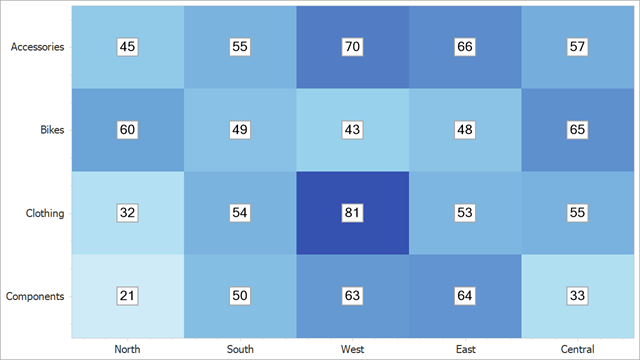HeatmapLabel.Pattern Property
Gets or sets a string pattern that formats heatmap label text.
Namespace: DevExpress.XtraCharts.Heatmap
Assembly: DevExpress.XtraCharts.v25.1.dll
NuGet Package: DevExpress.Charts
Declaration
[XtraChartsLocalizableCategory(XtraChartsCategory.Behavior)]
public string Pattern { get; set; }Property Value
| Type | Description |
|---|---|
| String | A format string. |
Remarks
Patterns can comprise plain text and placeholders with format specifiers. The following table lists available placeholders:
| Placeholder | Description |
|---|---|
| {X} | Displays a heatmap cell x-argument. |
| {Y} | Displays a heatmap cell y-argument. |
| {V} | Displays a heatmap cell value. |
When the Heatmap control is bound to data, the pattern can contain data field names in addition to placeholders. For example, you can use the "{CustomText}" pattern for data items similar to the following:
<Item>
<Country>China</Country>
<Product>Computer</Product>
<Value>-151.9</Value>
<CustomText>Test</CustomText>
</Item>
The following code shows how to use custom placeholders to format heatmap labels:
Example
The following example shows how to configure heatmap cell label settings such as format, font, color, and so on.

Use the HeatmapControl.Label property to access label settings:
using DevExpress.Drawing;
using DevExpress.XtraCharts;
using DevExpress.XtraCharts.Heatmap;
using System;
using System.Drawing;
using System.Windows.Forms;
namespace HeatmapMatrixAdapterSample {
public partial class Form1 : Form {
public Form1() {
InitializeComponent();
HeatmapControl heatmap = new HeatmapControl();
this.Controls.Add(heatmap);
heatmap.Dock = DockStyle.Fill;
HeatmapMatrixAdapter dataAdapter = new HeatmapMatrixAdapter();
dataAdapter.XArguments = new string[] { "North", "South", "West", "East", "Central" };
dataAdapter.YArguments = new string[] { "Components", "Clothing", "Bikes", "Accessories" };
dataAdapter.Values = new double[,] {
{ 21.3, 50.1, 63.2, 64.4, 33.4 },
{ 32.3, 54.4, 81.3, 53.4, 54.9 },
{ 60.3, 49.1, 42.6, 48.4, 65.4 },
{ 45.3, 54.7, 70.3, 66.4, 56.6 }
};
heatmap.DataAdapter = dataAdapter;
Palette palette = new Palette("Custom") { Color.White, Color.SkyBlue, Color.DarkBlue };
RangeColorProvider colorProvider = new RangeColorProvider() { Palette = palette, ApproximateColors = true };
colorProvider.RangeStops.Add(new Unit(0, UnitType.Percentage));
colorProvider.RangeStops.Add(new Unit(20, UnitType.Absolute));
colorProvider.RangeStops.Add(new Unit(40, UnitType.Absolute));
colorProvider.RangeStops.Add(new Unit(60, UnitType.Absolute));
colorProvider.RangeStops.Add(new Unit(90, UnitType.Absolute));
colorProvider.RangeStops.Add(new Unit(1, UnitType.Percentage));
dataAdapter.ColorProvider = colorProvider;
HeatmapLabel label = heatmap.Label;
label.Visible = true;
label.Pattern = "{V:f0}";
label.BackColor = Color.White;
label.Color = Color.Black;
label.DXFont = new DXFont("SegoeUI", 10);
label.TextOrientation = HeatmapTextOrientation.Horizontal;
label.Border.Visibility = DefaultBoolean.True;
label.Border.Color = Color.DarkGray;
label.Border.Thickness = 2;
}
}
}
Related GitHub Examples
The following code snippets (auto-collected from DevExpress Examples) contain references to the Pattern property.
Note
The algorithm used to collect these code examples remains a work in progress. Accordingly, the links and snippets below may produce inaccurate results. If you encounter an issue with code examples below, please use the feedback form on this page to report the issue.